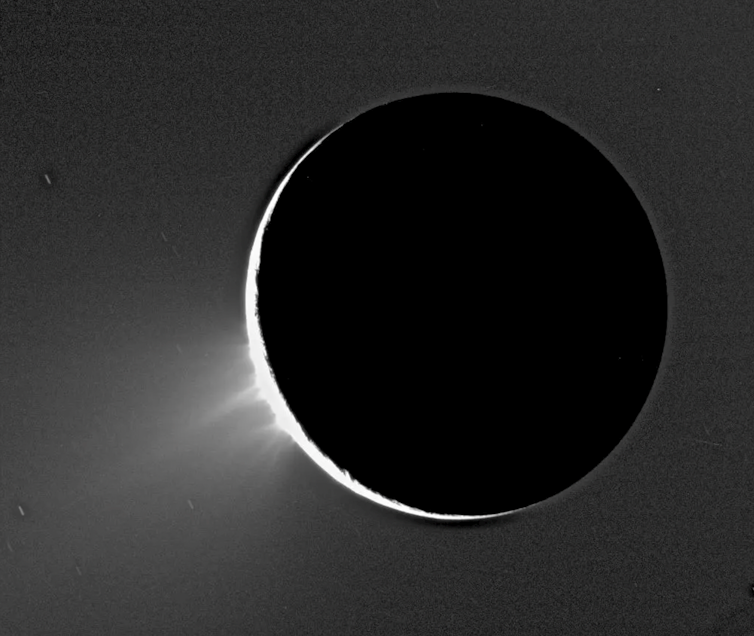Jupiter’s icy moon Europa has long been thought to be one of the most habitable worlds in the Solar System. Now Juno’s mission to Jupiter has directly sampled its atmosphere in detail for the first time. The results, published in Nature Astronomy, show that Europa’s icy surface produces less oxygen than we thought.
There are many reasons to be excited about the possibility of finding microbial life on Europa. Evidence from the Galileo mission showed that an ocean exists beneath the Moon’s icy surface, containing about twice as much water as the oceans on Earth. Additionally, models from Europa data show that the ocean floor is in contact with rocks, enabling energy-producing chemical water-rock interactions, making it a prime candidate for life.
Meanwhile, telescope observations reveal a tenuous, oxygen-rich atmosphere. It also looks like water clouds are erupting intermittently from the ocean. And there is some evidence of the presence of basic chemical elements at the surface used by life on Earth, including carbon, hydrogen, nitrogen, oxygen, phosphorus and sulfur. Some of these can leak into water from the atmosphere and the surface.
The warming of Europa and its ocean is thanks in part to the Moon’s orbit around Jupiter, which produces tidal forces to warm the otherwise cold environment.
Although Europa has the three basic ingredients for life (water, the right chemical elements, and a heat source), we don’t yet know if there is enough time for life to develop.

The other major candidate in our solar system is Mars, the target of the Rosalind Franklin rover in 2028. Life on Mars may have begun at the same time as on Earth, but then ceased, possibly due to climate change.
A third candidate is Saturn’s moon Enceladus, where the Cassini-Huygens mission discovered clouds of water coming from the salty ocean beneath the surface and also in contact with rocks on the ocean floor.
Titan ranks fourth with its thick atmosphere composed of organic compounds, including hydrocarbons and tholins, born in the high atmosphere. These then float to the surface, covering the surface with materials that will last a lifetime.
lose oxygen
The Juno mission contains the best charged particle instruments ever sent to Jupiter. It can measure the energy, orientation and composition of charged particles on the surface. Similar instruments on Saturn and Titan found tholins (a type of organic matter) there. But they also measured particles suggesting an atmosphere on Titan and Enceladus, as well as Saturn’s moons Rhea and Dione.
These particles are known as aggregation ions. Planetary atmospheres consist of neutral particles, but the upper atmosphere “ionizes” (i.e. loses electrons) in sunlight and through collisions with other particles, creating ions (charged atoms that have lost electrons) and free electrons.
When plasma, a charged gas that forms the fourth state of matter beyond solid, liquid, and gas, passes through an atmosphere with newly formed ions, it perturbs the atmosphere with electric fields that can accelerate the new ions (the first part of an ion). receiving process.
These collector ions then spiral around the planet’s magnetic field and are usually lost in the atmosphere, while some hit the surface and are absorbed. The accretion process cleared the Martian atmosphere of particles after the red planet’s magnetic field disappeared 3.8 billion years ago.
Europa also has a procurement process. New measurements show signs of the uptake of molecular oxygen and hydrogen ions from the surface and atmosphere. While some of them escape from Europa, some of them hit the icy surface, increasing the amount of oxygen on the surface and below.
This confirms, in agreement with remote observations, that oxygen and hydrogen are indeed the main components of Europa’s atmosphere. But measurements show that the amount of produced oxygen released into the atmosphere by the surface is only 12 kg per second, with previous estimates at the lower end of 5 kg to 1,100 kg per second.
This shows that the surface has suffered very little erosion. Measurements show that this may account for only 1.5 cm of Europa’s surface per million years; This is less than we think. Europa is therefore constantly losing oxygen due to accretion processes; Only a small amount of additional oxygen is released from the surface to replenish it and rise to the surface again.
So what does this mean for the chances of hosting life? Some of the oxygen trapped at the surface can find its way to the subsurface ocean to fuel life there. However, based on the study’s estimate of overall oxygen loss, this should be within the previously estimated range of 0.3 kg to 300 kg per second.
It is not yet known whether this rate recorded on September 29, 2022 is normal. Maybe it doesn’t represent the general oxygen on the moon. The eruption of these clouds, orbital position and upstream conditions may increase and decrease respectively at certain times.
NASA’s Europa Clipper mission, which will launch later this year, and the Juice mission, which will make two flybys to Europa on its way to Ganymede orbit, will be able to follow these measurements and provide much more information about the habitability of Europa.
This article is republished from The Conversation under a Creative Commons license. Read the original article.


Andrew Coates receives funding from STFC and UKSA (UK).